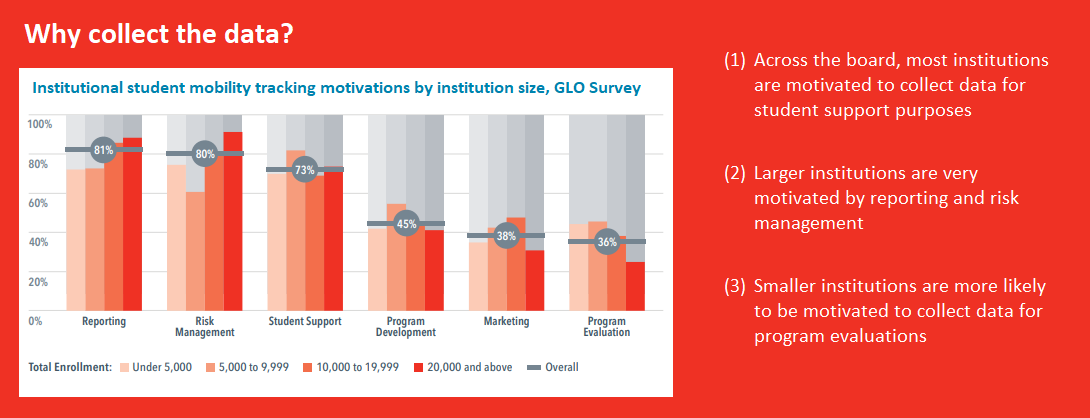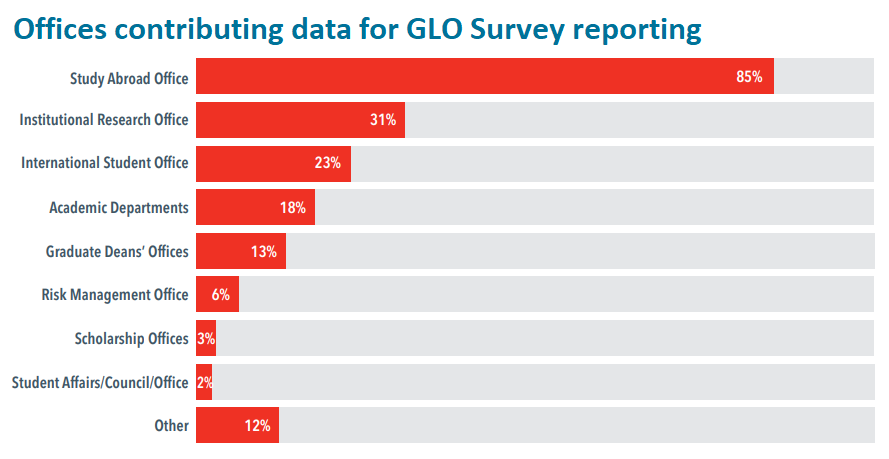Module 1: Fundamentals for Graduate Learning Overseas Data Collection
Module 1 discusses essential concepts for establishing data collection. It addresses why student mobility data collection is important, how it can inform international education at your institution, and who should be a part of discussions on graduate student learning overseas.
This module is designed to set the foundation for graduate learning overseas data collection and connects directly to modules two and three on systems and databases, and intra-campus collaboration. It will guide your data collection planning by focusing on the information you need to collect and with whom you will share it, so that you can determine how to best advance data collection at your institution.
Key questions for this module:
Defining student mobility
|
Key take-aways:
|
Defining student mobility
What is student mobility? Who do I count?
The formal definition of student mobility is when students undertake all or part of their higher education experience in a country other than their home country or who travel across a national boundary to a country other than their home country to undertake all or part of their higher education experience (IIE Project Atlas). The resources section at the end of this module highlights slight variations on this definition.
For the purposes of your institutional data collection and later use of student mobility data, IIE recommends that your institution collect data on student mobility for all students enrolled at your institution who fit the above definition of a mobile student. However, this data will be most useful to you if you can further break down specific characteristics about the individual into commonly requested categories for reporting purposes. IIE recommends the following broad categories for individuals:
|
Student type |
Definition |
|
U.S. based students |
Individuals who are U.S. citizens, permanent residents, or who are based in the United States. |
|
International students |
Individuals who are enrolled in coursework on a temporary visa that allows for academic study in the United States. |
|
Degree seeking students |
Individuals who are studying toward a degree at your institution.
|
|
Non-degree students |
Individuals who are enrolled at your institution but are not pursing a degree. |
|
Graduate students |
Individuals who are pursuing a Masters, Doctoral, or other post-baccalaureate degree at your institution. |
|
Undergraduate students |
Individuals who are pursuing an Associates or Baccalaureate degree at your institution. |
|
Credit seeking students |
Individuals who are participating in an overseas learning experience for academic credit. |
|
Non-credit students |
Individuals who are participating in an overseas learning experience and will not receive academic credit. |
By capturing all these groups in your data collection, you will be better equipped to understand the complete picture of student mobility at your institution. For the purposes of this toolkit, the breakdown is a critical step in allowing you to identify graduate students, both those participating in learning overseas for academic credit and those who are not receiving credit.
Why count students who are engaged in learning overseas?
An accurate and comprehensive data set of globally mobile students can educate and inform stakeholders and support decision making practices across your institution. Findings from the data can help you to convey institutional, faculty, and student benefits to all stakeholders.

Student mobility data can be analyzed to inform:
- Institutional priorities and strategy
- Funding allocations
- Emergency response
- Risk management and liability practices
- Safety and security support systems
- Medical insurance and health care support
- Standard reports (Ex. accreditation, bi-annual reports)
- Institutional rankings
- Program design
- Student support
- Outreach and recruitment for learning overseas
The last section of this module on communicating data will address these bullet points in greater detail.
Why count graduate students who are learning overseas?
Graduate students comprise a growing portion of U.S. higher education enrollments. Through our GLO research, we learned that at many institutions the record of graduate students’ learning overseas is an undercount.
Counting graduate students who are overseas is critical to ensuring:
- Your risk management and liability plans account for the destinations graduate students travel to and activities that they participate in while overseas.
- All students are enrolled in your institution’s systems that provide health, safety, and security support to students while overseas.
- All students representing your institution overseas have been orientated and are prepared for learning overseas.
Additional institutional benefits for counting graduate students are noted in the subsequent sections on collecting and communicating data.
How is collecting mobility data at the graduate level different than collecting mobility data for undergraduate students?
Throughout the GLO project, the research team heard from higher education professionals that, when it came to education abroad, graduate students simply have different needs and their learning overseas were more ‘niche’ experiences that didn’t necessarily involve the resources or support of a study abroad office. Our research team sought to clarify what it means for graduate students to have different needs in the education abroad context and how these differences impact data collection and accountability.
Graduate students differ from their undergraduate peers in numerous ways, among them age, maturity, work, and family obligations. These factors may influence the duration, location, and circumstances around learning overseas activities. Graduate students participate in more overseas activities categorized as experiential learning than traditional study abroad or coursework. Experiential learning at the graduate level may also be non-credit bearing, meaning they are less likely to be recorded in academic systems. These experiential learning activities are the same activities that institutions feel least confident in their ability to report.

To capture comprehensive data on graduate student learning overseas specifically, institutions’ collection practices must account for:
- Independent activities overseas such as research, field work, internships, and volunteer opportunities
- Non-credit learning overseas
- Short duration learning overseas
By focusing on intentional practices to collect information on students who participate in these types of learning overseas, you will be able to see a more comprehensive picture of graduate student learning overseas from your institution.
Modules 2 and 3 will guide you through intentional practices to leverage resources, relationships, and the requirements at your institution for the purposes of graduate learning overseas data collection. Resources refers to the systems and databases that already exist and record information about graduate students at your institutions. Relationships ensure that you are connected to the relevant offices and individuals at your institution that enter and use graduate student information in institutional systems and databases. And requirements rely on the policies put into place at your institution for graduate students, faculty, and staff that support your efforts to receive data input about graduate students learning overseas.
Collecting data
Who is involved in collecting student learning overseas data at your institution?
While there is variation in how graduate learning overseas data is collected at each institution, you can be assured that a wide range of stakeholders are involved in the process. At most institutions, data collection exists at a variety of student touchpoints and is brought together by one person or a central office.

Identifying the offices and individuals at your institution who can help you to achieve your data collection goals is a critical step towards comprehensive data collection. Once you know who is ready and able to assist, review the practices in Module 3 on Intracampus Collaboration and select those that best fit your institution.
Why is conscious data collection necessary?
If you don’t collect it, you won’t be able to report on it! And even more importantly, just because you collected the data doesn’t mean you are set up to pull it back out in a report. Conscious data collection is about thinking ahead and planning for the structure that meets your data reporting needs.
- Consider what information is displayed in your ideal student mobility report(s) and the different ways you may want to view the same information.
- Work with a data scientist, IT personnel, or other knowledgeable source at your institution to identify each of the data points or variables you will need to collect to create the report(s) you desire.
- Consider how each variable is defined and document the definitions in a data dictionary (See an example in the University System of Georgia Case Study).
- Review which departments or offices at your institution are already collecting the desired variables. (See Module 3)
Putting in the time up front to define your variables and structure your database and reports carefully will save you valuable time down the road.
Communicating data
Who are the key stakeholders at your institution?
Think Big! The key stakeholders at your institution include:
- leadership positions
- Senior International Officers
- faculty
- staff
- students
- prospective students
- parents
Each audience has a different interest in your data on graduate student learning overseas. Tailored messages to each group that highlight trends in overseas learning can support your institution’s education abroad goals.
How can data on graduate learning overseas be used for learning with institutional leadership?
Ensuring your institutional leadership is well versed in education abroad activities at your institution can go a long way in supporting faculty and students achieve their overseas learning goals. Consider preparing a presentation or one-page handout that can:
- INFORM RISK MANAGEMENT. Institutional leadership may be drawn to data that can inform risk management and liability. Knowing where graduate students are overseas can inform risk management policies and provide, or flag the need to provide, greater support to students traveling to high risk destinations. (See Module 2 for more on risk management systems)
- SHOW IMPACT. Data can also show provosts, deans, faculty, and other stakeholders the impact of graduate learning overseas at your institution. Share feedback with institutional leadership that shows how programs are meeting students’ needs or provide necessary recommendations to improve programs for future students. This crucial information about graduate learning overseas can serve to gain support and buy-in from both provosts and deans, as well as the faculty under their purview.
- HIGHLIGHT INSTITUTIONAL SUCCESSES. Institutional leadership are responsible for submitting reports reflecting institutional achievements for an external audience. Conscious data collection will improve the accuracy of data and statistics provided for accreditation and bi-annual reports as well as national surveys and grant reports enabling your institution to be given credit for programming and achievements in international education. These reports may inform external parties who make decisions such as funding or institutional rankings. Showing the extent of education abroad at your institution has the potential to increase rankings among peer institutions and lead to greater prestige for your institution.
How can data on graduate learning overseas be used for learning with faculty and staff?
- SHOW IMPACT OF EDUCATIONAL OUTCOMES. By sharing data on educational outcomes achieved through learning overseas, faculty can strengthen or expand partnerships across disciplines.
- INFORM PROGRAM DESIGN. By sharing data on how variables such as the duration, location, and subject matter focus of overseas learning meet the needs of graduate level students, faculty are empowered to design more effective programming and equipped to guide students towards appropriate programs.
How can data on graduate learning overseas be used for learning with students?
- ENROLLMENT IN HEALTH, SAFETY AND SECURITY SYSTEMS. Students who enroll in centralized health, safety, and security systems have access to health insurance, medical care, and emergency support when they need it.
- OUTREACH AND RECRUITMENT. Sharing data on how students have integrated learning overseas opportunities to achieve educational outcomes necessary for their academic preparation will show current and prospective students how they can plan for and build an international education experience into their academic plan.
|
Considerations:
|
Resources
Defining student mobility: